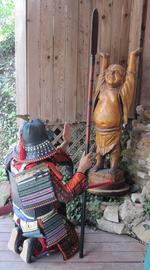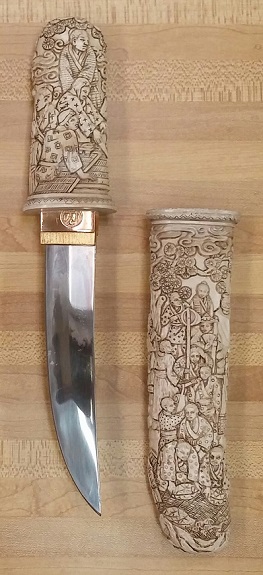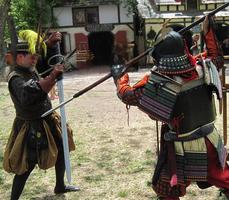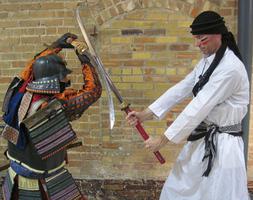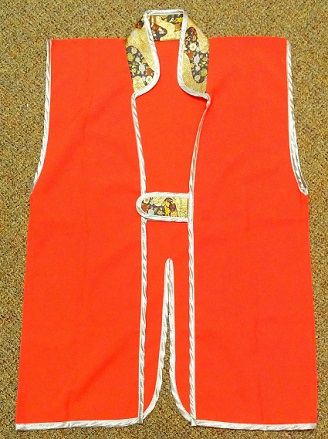Subject: hatamoto samurai 'bannerman' warrior guard
Culture: Japanese
Setting: late Muromachi / Aizuchi-Momoyama, Japan 1544-1643
Evolution: 1020 Heian bushi > 1221 Kamakura samurai > 1336 Nanbokucho samurai > 1467 Muromachi samurai > 1568 Momoyama hatamoto samurai
Context (Event Photos, Primary Sources, Secondary Sources, Field Notes)
* Turnbull/Hook 2010 p4-5
"The word hatamoto has the literal meaning of 'beneath the flag', because it was directly underneath the flags and battle standards of the daimyo (Japan's feudal lords) that one would have found the samurai warriors who bore this most noble of titles. They made up the daimyo's mounted and foot guards; served on his general staff, to plan strategy and to supervise his military administration; or provided immediate personal services to their lord, of which the most important of all was the shared duty of protecting his person. Every hatamoto, therefore, was to some extent a true guardsman who was willing to throw himself in front of his lord when danger threatened -- which was no more than would be expected from these bravest and most loyal of all samurai warriors."
* Vuksic/Grbasic 1993 p114 (describing mounted samurai, sixteenth century)
"The drawn-out feudal struggles among the great lords, which began in the twelfth century, loosened the bonds of imperial authority, but also made the samurai influential, turning them into a privileged military caste. Most were tied to the feudal lords, who did not give them land holdings but paid them in kind. The most privileged of the samurai were the bannermen (hatamoto), vassals of the shogun, militarily the strongest feudal lord in Japan, who was the country's true ruler; the emperor was no more than a figurehead. The task of the hatamoto was to go to war for the shogun and, in times of peace, to oversee his holdings and collect taxes."
* Turnbull/Hook 2010 p7
"The first use of the word hatamoto appears during the Sengoku Period (1467-1615). This was the 'Age of Warring States', when scores of minor daimyo seized power for themselves in their immediate localities and fought each other until, during the mid-16th century, a comparative handful of 'super-daimyo' competed with each other on a grand scale before Japan was finally reunified. The original meaning of hatamoto, however, referred less to the men and more to the place where they gathered. This area 'beneath the flag' was most precisely defined when a general (who was usually the daimyo himself, but might be a highly trusted follower) set up his field headquarters on the march or in immediate preparation for battle."
Armor
* Art of the samurai 2009 p40 (Ikeda Hiroshi, "Japanese armor: An overview" p37-115)
"In the sixteenth century, warfare in Japan evolved once again, from encounters between hundred of combatants to organized battles between thousands of foot soldiers. The yari, a thrusting and cutting spear, was adopted, and at mid-century, firearms based on European examples became decisive factors in battle, particularly in those of the Tenshō era (1573-1592). ... As the demand for armor increased, sets were sometimes constructed using older components. These 'recycled' armors are known as shikaeshi mono. In addition, simple, inexpensive helmet bowls were made, including the kensu, a roughly made form of suji-kabuto; the shii-nari ('acorn' shape), with its prominent tehen; and the so-called zunari ('head-shaped') bowl made of three iron plates -- one at the center and one on either side -- in a type of construction known as sanmaibari. Conversely, elaborate forms of purely decorative helmets, known as kawari-kabuto, also became popular. Appended to these were various fixtures, from animal hair to three-dimensional representations of mountainous landscapes, animals, and other objects. Yet another helmet type made at this time, the hineno nari, is characterized by a neck guard that is shorter on the sides then in the back. The great diversity of helmet types and decorations during this period is probably the result of a rising awareness of the symbolic potency of the kabuto in the midst of massed armed conflict.
"Increasing demand for armor and the adoption of the gun and spear brought about substantial changes in the form of the dō, the most notable of which was the use of large plates of hammered iron instead of sane. Another important change was the development of a simple dō consisting of riveted plates that close on the right side, to which ko-gusoku ('small equipment') was added, including face covers (mengu), sleeves (kote), thigh guards (haidate), and shin defenses (sune-ate). The kote and haidate are composed of sane and iron mesh (kusari) sewn onto an undercloth known as ieji. When completed in this fashion, such armor was often referred to as gusoku ('full equipment,' meaning a complete set), and in the late Muromachi period it came to be known as tōsei gusoku ('equipment of the times') to distinguish it from the earlier haramaki and dō-maru.
* Sinclaire 2001 p30-34
"Great changes in armour were made in the latter half of the 16th century, which reflect the battle conditions of the day. Rather than the fully laced do of earlier, full metal do of a one-piece construction were introduced. While their main function was to be more bullet proof now that firearms had been introduced into the country, the old kebiki or close-laced armours were unsuited to the long continual campaigns of the time. When soaking wet they became very heavy and were difficult to clean and dry, becoming unpleasant in summer and freezing in winter. It has been suggested that in the humid conditions found in Japan the lacing would easily rot and there is no doubt that it was possible that a spear or other weapon could be trapped in the lacing. Even worse, it might become the object of insect infestation, adversely affecting the health of the wearer. The kebiki-laced do was also thought to be weaker because of the large number of holes required in the metal plates to accomodate the close lacing.
* Art of the samurai 2009 p24 (Ikeda Hiroshi, "Japanese armor: An overview" p37-115)
"Because the conventional Japanese armor (yoroi), composed of small iron or leather plates laced together, was poor defense against either the gun or the yari, sheet iron came to be used for the cuirass. Some armors of this type were imported from Europe and are referred to as namban-dō. Eventually, armor that could be mass-produced was introduced; these are known as tōsei gusoku, or 'modern armor.' There are a number of theories regarding the origin of kawari-kabuto, the 'exotic' helmets that became popular in the Muromachi period and which are distinguished by their often grand, naturalistic, and sculptural shapes. The use of matchlock firearms on the battlefields of Japan encouraged the adoption of simpler types of helmets, such as the zunari-kabuto (head-shaped helmets), which have smooth surfaces formed of three to five iron plates and were designed to deflect musket balls. In this way they were much more effective against firearms than the traditional but more attractive hoshi-kabuto and suji-kabuto, which were constructed of dozens of small iron plates. It is thought that to make helmets of zunari-kabuto type more attractive, and to make themselves more imposing on the battlefield, samurai commanders added large and decorative maedate (crests) of various shapes to zunari-kabuto and other simpler forms of helmets. Also, once firearms and artillery were introduced to Japan they were adopted very rapidly, widely, and effectively. (Some writers even maintain that there were more matchlock guns in Japan than in any other country in the world.) Guns and cannon produce copious amounts of black smoke, however, severely restricting visibility. It is possible, therefore, that kawari-kabuto, with their dramatic shapes and sizes, were developed, at least in part, in response to the need for commanders to be clearly seen by their troops under battlefield conditions. (Some commanders even injected a sense of humor by incorporating wooden grave markers [gorintō sotoba] on the top of their helmets.) Given the strong influence of nanban styles at the time, it is also possible that ornate and highly embossed European helmets, such as the famous lion-headed helmet in the collection of the Metropolitan Museum of Art, may have also contributed to the creation of the kawari-kabuto fashion. The same influence can be seen in the large and exotic umajirushi (camp standards) and sashimono (personal flags) as well as jinbaori (armor surcoats) decorated with bold designs on cloth imported from Europe."
Spear
* Samurai warrior 2022 p70-71
"It was ... simpler for a mounted warrior to abandon his bow altogether in favour of a yari. The yari was constructed from a straight blade that sharpened to an end point. This made it a versatile weapon taht could be used by a horseman in the fashion of a lance from medieval Europe, but also allowed for the slashing action of a naginata. ...
"Both Oda Nobunaga and Toyotomi Hideyoshi were great advocates of the yari, awith samurai of the Oda clan carrying yari over 6m (19ft) long. Seven of Hideyoshi's generals who outdid themselves with yari at the 1583 Battle of Shizugadake became famously known as the 'Seven Famous Spearmen of Shizugatake'. One of these samurai was Katō Kiyomasa whose skill with the yari was further demonstrated during teh Korean invasion of 1592. Here, Kiyomasa famously speared a tiger while subduing the inhabitants of the country's north east.
"By the time of the 1600 Battle of Sekigahara, the yari had overtaken the naginata as the polearm of choice, and the weapon was used extensively by Tokugawa Ieyasu's front lines. It was also used to great effect during the Siege of Ōsaka's Battle of Tennoji, the last pitched battle of the samurai."
* Turnbull 2004 p172-173
"The straight spear, or yari, first appeared as an infantry weapon during the fifteenth century, and within a hundred years different varieties became the favored weapons for both mounted samurai and foot soldiers. Although by no means as versatile as the naginata, the yari was ideal for the tight and busy conditions of a battlefield where movement was restricted anyway. The samurai's yari, usually called a machi yari (held spear), would be no more than 13 feet (4m) long.
* Samurai warrior 2002 p71 caption
"Yari from the mid-sixteenth century hada lacquered, hardwood shaft between 4m and 6.5m (13ft 1in-21ft 4in) long. A typical yari blade was up to 1 m (3ft 3in) long and made of the same tamahagane steel as a samurai sword."
Swords
* Art of the samurai 2009 p175 (Kazutoshi Harada, "History of the Japanese sword" p117-191)
"At the end of the Muromachi period (late 16th century), the provinces of Japan were controlled by powerful military commanders who fought frequently in order to guard or expand upon their territories. The swords of the time were made light and short so that they could be wielded with one hand."
* Art of the samurai 2009 p121 (Kazutoshi Harada, "History of the Japanese sword" p117-191)
"During these decades of struggle among the daimyo, the Japanese sword underwent further substantial changes, particularly between the last years of Toyotomi Hideyoshi's rule and the rise of Tokugawa Ieyasu. For one, the katana largely replaced the tachi because it was easier to use on foot in conjunction with a spear or firearm." ...
* Harris 2004 p35
"Swords made during the Momoyama period were similar in shape to the shortened swords of the Kamakura and Nambokuchō periods, and the hamon of those periods were also emulated. In particular, smiths made swords with large nie, similar to the work of Masamune and his school of Sōshū."
* Art of the samurai 2009 p120-121 (Kazutoshi Harada, "History of the Japanese sword" p117-191)
"By the second half of the sixteenth century, it was standard for samurai to wear two swords -- one long and one short -- through the belt, and this pairing of swords (daishō) was formalized during the Edo period. The Japanese sword thus falls generally into one of three classifications: tachi, suspended with cords with the edge down, in use from the Heian through the early Muromachi periods; katana, the longer of the two swords carried through the belt, in use beginning about the middle Muromachi period; and the wakizashi, the shorter sword worn through the belt along with a katana."
* Turnbull/Hook 1979 p17-18
"The daisho (pair of swords) was the mark of the samurai. The larger, called the katana, was the standard fighting sword, and for a well-to-do samurai this would be of exceptional workmanship and was often a treasured possession or heirloom. The blade of the sword was slightly curved, making it ideal as a cutting and slashing weapon in the two-handed Japanese style. Along the blade of the best examples could be discerned a wavy temper line where the hard steel of the cutting edge met and was surrounded by the softer steel of the sword body, giving strength and springiness. The tang of the blade fitted tightly into the wooden handle, which was covered in same, the skin of the giant ray, and then bound tightly with dark-blue silk braid to give a firm grip. A small round tsuba, or sword-guard, was fitted where the blade entered the hilt. The scabbard would probably be lacquered, and would bear on it a small projection through which the sageo, a silken cord, was passed to make the scabbard fast in the belt.
"The short sword (wakizashi) would be of identical style. Both were carried with the cutting edge uppermost so that a deadly blow could be delivered direct from the scabbard."
* Art of the samurai 2009 p24 (Ogawa Morihiro, "The spirit of the samurai" p3-35)
"A katana by Sukesada, with its strong saki-zori curvature (increasing near the point) and [blade] length of about 66 centimeters (26 inches), is typical of blades from the late Muromachi period. Wakizashi were of the shinogi-zukuri type and were about 56 centimeters (22 inches) long. It became customary to wear an uchigatana and a wakizashi thrust together through the belt, a practice that gave birth to the later daishō (matching pair of swords) style."
Baton
* Arms and armor 2002 p61
"Sai hai were carried as signs of rank and used by military commanders to give the signal for an attack."
Dagger
* Art of the samurai 2009 p24 (Ogawa Morihiro, "The spirit of the samurai" p3-35)
"Tantō were generally hira-zukuri in form, of small proportions (about 20 centimeters [77/8 inches] long), and were made with a slight inward curvature. This period also saw the appearance of the double-edged (moroha-zukuri) shinogi-zukuri type of tantō ."
Costume
* Turnbull/Hook 1979 p17
"The clothes a samurai would wear when not actually prepared to fight a battle, that is when not in armour, would depend upon the degree of formality of the occasion. The basic male dress was the kimono, a long, wide-sleeved garment like a dressing-gown, reaching to well below the knee, sometimes worn over a similarly shaped white undergarment that showed at the neck. It would be held in at the waist by a long sash-like belt which was wrapped round two or three times before being tied at the front. Into this belt the samurai thrust his swords.
"The kimono would suffice the samurai if he was off to enjoy himself on a summer's evening, and probably all he would wear under it would be a fundoshi, or loincloth. Otherwise he would wear in addition a pair of hakama, or wide trousers. The hakama were rather like a divided skirt. They were stiffened and had a low crotch with large openings at the sides, and were held in place by two sets of ties on the front and rear parts, fastening round the waist. The hakama came to the ankle, and when wearing them the swords would still be carried in the kimono belt but outside the hakama."
* Fashion, costume, and culture volume 2 2004 p208
"Samurai were dressed for speed and travel. Their basic uniform had wide hakama trousers, open halfway down the leg and ending above the ankle. The under-kimono of the samurai could be slipped off for a sword battle, while remaining secured at the waist by the hakama's hard waist band and ties. The overvest had impressive winged shoulders and was sleeveless, so that the samurai looked both grand and dangerous and was able to swing his arms around with his two swords."

